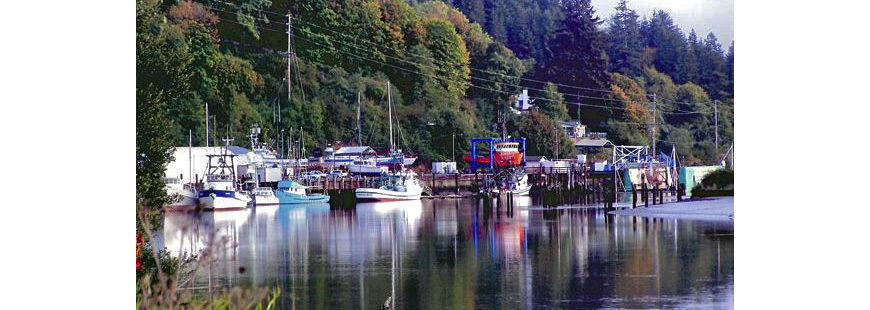Photo: Boatyard in Toledo, Oregon
Since its inception, the Marine Fish Conservation Network has advocated on behalf of fishing communities. Working waterfronts are a vital part of the coastal ecosystem: commercial docks, provisioners, small-boat marinas and boatyards, charter operators, day boats, tackle shops, wholesale and retail fish markets, processing plants, restaurants, aquaria, ecotourism, and a host of ancillary businesses that are part of the “blue economy.”
Every year the National Oceanic and Atmospheric Administration monetizes the economic contributions of commercial and recreational fishing. The most recent report, “Fisheries of the United States, 2015,” reveals steady productivity in both sectors. Commercial vessels landed seafood valued at $5.2 billion. While the report does not attempt to quantify the economic value of the recreational sector, it found that anglers took 61 million recreational fishing trips, landing some 351 million fish. A separate survey by an online statistics portal calculated that recreational fishermen spent $686 million on state and local licenses alone.
While the data are impressive, they tell only part of the story for community-based commercial and recreational fishermen and businesses. NOAA makes a point of listing the five states with the largest share of commercial fishing—Alaska, Massachusetts, Maine, Louisiana, and Washington—which together haul in more than $3.5 billion in seafood annually. Many of the fisheries in these states are dominated by large companies that generate the bulk of revenue—and take the lion’s share of the catch. But what about the other $1.7 billion worth of landings that make up the total $5.2 billion? Most of this occurs in small ports that dot America’s coasts from Rhode Island around to Oregon. These communities are not household names: Freeport, New York; Camden Point, North Carolina; or Toledo, Oregon, population 3,500, on the Yaquina River seven miles upriver from the coast.
Toledo epitomizes the future of U.S. fishing. This small community is knit together by a strong fishing tradition dating back at least to 1910. But it faced increasing competition from nearby ports along the coast while at the same time local processing plants shut down when most of the local catch went overseas for processing. This left local markets with scant fresh fish. Toledo decided to change this pattern.
In 2014, the Port of Toledo won a $5 million economic development grant from the state to improve facilities and spur economic growth in the region. This grant and other awards have enabled Toledo to improve the harbor’s main commercial boatyard and to purchase a mobile haul-out capable of lifting 660 tons. These improvements dovetail with a new processing plant opened by Fishpeople of the Pacific Northwest, a certified B-corporation that sells fresh and prepared seafood directly to the public.
With these improvements, Toledo hopes to become the hub of the region’s “dock to dinner plate” movement. Fishpeople intends to meet the needs of seafood customers who demand fresh, eco-friendly, and sustainably caught products. The plant produces “value-added” seafood. It processes and packs meal-size pouches with seasonings and other ingredients sourced from local Oregon farms. The entrees are fully cooked requiring only a quick warm-up before serving.
Toledo’s success to date and its future as a driver for the region’s economy depend on a sustainable supply of fish and, as important, the people who catch it. This is true of every port, large or small, in this country. Fortunately, 2016 marked a good year for Oregon’s fishermen, particularly because of the robust harvest of Dungeness crabs, which offset downturns in other important fisheries. The crab fishery rebounded because of careful management by the Pacific Fishery Management Council, which controls access to federal fisheries from California to Washington.
Many people think the Council’s actions only affect fish stocks, but its management decisions have a profound effect on fishermen. Experience shows that enhancing local participation in fisheries management and supporting working waterfronts benefit coastal communities both socially and economically. That’s why the long-term success of ports like Toledo depends on measures to ensure that fishing communities have continuous access to fisheries and that artificial barriers don’t prevent new generations of fishermen from gaining entry.
The vitality and growth of coastal communities depend on sustainable catches over the long-term. As one Toledo fisherman put it, “We are a place defined by our fish. We are all fish people.”


